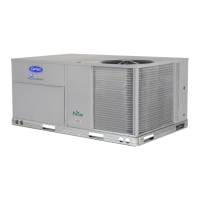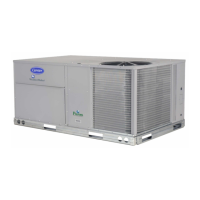150
• Differential dry bulb
• Outdoor air enthalpy curves
• Differential enthalpy
• Custom curves (a combination of an enthalpy/dewpoint
curve and a dry bulb curve).
The units are equipped as standard with an outdoor air enthalpy
control. Outside air and return air dry bulb sensors which sup-
port the dry bulb changeover method are also supplied as stan-
dard. If the other methods are to be used, then a field-installed
humidity sensor must be installed for outdoor air enthalpy and
customer curve control and two humidity sensors must be in-
stalled for differential enthalpy. Installation holes are pre-
drilled and wire harnesses are installed in every unit for con-
nection of the humidity sensors. The ComfortLink controls
have the capability to convert the measured humidity and dry
bulb temperature into enthalpy.
ACCESSORY NAVIGATOR™ DISPLAY
The accessory handheld Navigator display can be used with the
48/50P Series units. See Fig. 36. The Navigator display oper-
ates the same way as the scrolling marquee device. The RXB
and EXB boards contain a second LEN port than can be used
with the handheld Navigator display.
Fig. 36 — Accessory Navigator Display
CONTROL MODULE COMMUNICATIONS
Red LED
Proper operation of the control boards can be visually checked
by looking at the red status LEDs as shown on Fig. 30-33.
When operating correctly, the red status LEDs should blink in
unison at a rate of once every 2 seconds. If the red LEDs are
not blinking in unison, verify that correct power is being sup-
plied to all modules. Also, be sure that the main base board is
supplied with the current software and that all boards are con-
figured on. If necessary, reload current software. If the problem
still persists, a board may need to be replaced. A board LED
that is lit continuously or blinking at a rate of once per second
or faster indicates that the board should be replaced.
Green LED
The boards also have a green LED. This green LED is the indica-
tor of the operation of the LEN communications, which is used for
communications between the boards. On the MBB board the local
equipment network (LEN) LED should always be blinking when-
ever power is on. All other boards have a LEN LED that will blink
whenever power is on and there is communication occurring. If
LEN LED is not blinking, check LEN connections for potential
communication errors (J3 and J4 connectors). A 3-wire sensor bus
accomplishes communication between modules. These 3 wires
run in parallel from module to module.
Yellow LED
The MBB has one yellow LED. The Carrier Comfort Net-
work
®
(CCN) LED will blink during times of network commu-
nication. The other boards do not have a CCN communications
port.
CARRIER COMFORT NETWORK
®
INTERFACE
The 48/50P Series units can be connected to the CCN if de-
sired. See Fig. 37. The communication bus wiring is a shielded,
3-conductor cable with drain wire and is field supplied and in-
stalled. See the Installation Instructions for wiring information.
The system elements are connected to the communication bus
in a daisy chain arrangement. The positive pin of each system
element communication connector must be wired to the posi-
tive pins of the system elements on either side of it. This is also
required for the negative and signal ground pins of each system
element. Wiring connections for CCN should be made at the
COMM board. See Fig. 20. Consult the CCN Contractor’s
Manual for further information.
NOTE: Conductors and drain wire must be 20-AWG (American
Wire Gage) minimum stranded, tinned copper. Individual
conductors must be insulated with PVC, PVC/nylon, vinyl,
Teflon, or polyethylene. An aluminum/polyester 100% foil shield
and an outer jacket of PVC, PVC/nylon, chrome vinyl, or Teflon
with a minimum operating temperature range of –20°C to 60°C is
required.
When connecting to a CCN communication bus, it is important
that a color-coding scheme be used for the entire network to
simplify the installation. It is recommended that red be used for
the signal positive, black for the signal negative and white for
the signal ground. Use a similar scheme for cables containing
different colored wires.
At each system element, the shields of its communication bus
cables must be tied together. If the communication bus is entirely
within one building, the resulting continuous shield must be con-
nected to a ground at one point only. If the communication bus
cable exits from one building and enters another, the shields
must be connected to grounds at the lightning suppressor in each
building where the cable enters or exits the building (one point
per building only). To connect the unit to the network:
1. Turn off power to the control box.
2. Cut the CCN wire and strip the ends of the red (+), white
(ground), and black (–) conductors. (Substitute appropriate
colors for different colored cables.)
3. Connect the red wire to (+) terminal on the COMM board,
the white wire to COM terminal on the COMM board, and
the black wire to the (–) terminal on the COMM board.
4. The RJ14 CCN connector on the COMM board can also
be used, but is only intended for temporary connection (for
example, a laptop computer running Service Tool).
5. Restore power to unit.
Ru
n Sta
tu
s
S
e
rv
ice
Te
s
t
T
em
p
era
ture
s
P
res
s
ure
s
S
e
tpo
in
ts
In
pu
ts
O
utp
uts
C
on
fig
u
ra
tion
T
im
e
Clo
ck
O
p
er
ating
M
od
es
A
la
rm
s
E
N
T
E
R
E
S
C
M
O
D
E
Ala
rm
St a
tus
T
IM
E
E
W
T
L
W
T
S
E
T
P
1
2
.
5
8
5
4
.
6
F
4
4
.1
F
4
4
.
0
F
N
A
V
I
G
A
T
O
R
C
o
m
f
o
r
t
L
in
k
IMPORTANT: A shorted CCN bus cable will prevent some
routines from running and may prevent the unit from starting.
If abnormal conditions occur, unplug the connector. If condi-
tions return to normal, check the CCN connector and cable.
Run new cable if necessary. A short in one section of the bus
can cause problems with all system elements on the bus.

